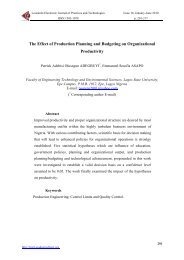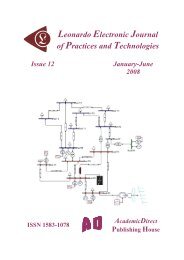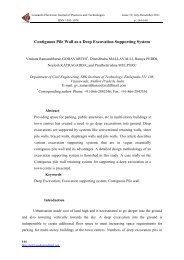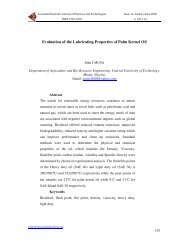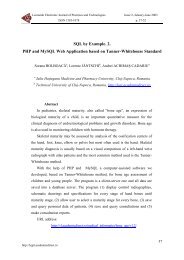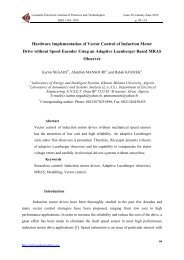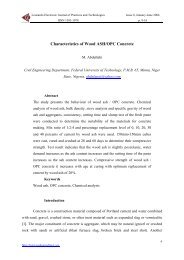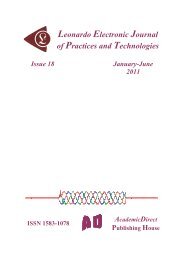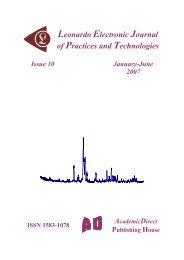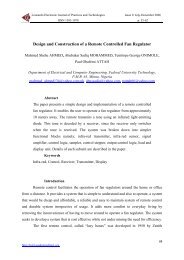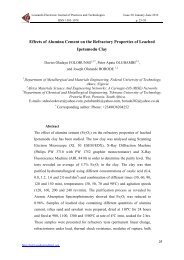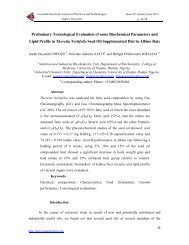Design and Fabrication of a Direct Natural Convection Solar Dryer ...
Design and Fabrication of a Direct Natural Convection Solar Dryer ...
Design and Fabrication of a Direct Natural Convection Solar Dryer ...
Create successful ePaper yourself
Turn your PDF publications into a flip-book with our unique Google optimized e-Paper software.
Leonardo Electronic Journal <strong>of</strong> Practices <strong>and</strong> Technologies<br />
http://lejpt.academicdirect.org<br />
ISSN 1583-1078<br />
Issue 18, January-June 2011<br />
p. 95-104<br />
<strong>Design</strong> <strong>and</strong> <strong>Fabrication</strong> <strong>of</strong> a <strong>Direct</strong> <strong>Natural</strong> <strong>Convection</strong> <strong>Solar</strong> <strong>Dryer</strong> for<br />
Tapioca<br />
Diemuodeke E. OGHENERUONA *1 Momoh O.L. YUSUF 2<br />
1<br />
Department <strong>of</strong> Mechanical Engineering, University <strong>of</strong> Port Harcourt<br />
2<br />
Department <strong>of</strong> Civil <strong>and</strong> Environmental Engineering, University <strong>of</strong> Port Harcourt,<br />
P.M.B. 5323, Choba, Rivers State, Nigeria<br />
E-mails: jideos@yahoo.com, ogheneruona.diemuodeke@uniport.edu.ng<br />
*Corresponding author: +2348056320209<br />
Received: 1 October 2010 / Accepted: 21 June 2011 / Published: 25 June 2011<br />
Abstract<br />
Based on preliminary investigations under controlled conditions <strong>of</strong> drying<br />
experiments, a direct natural convection solar dryer was designed <strong>and</strong><br />
fabricated to dry tapioca in the rural area. This paper describes the design<br />
considerations followed <strong>and</strong> presents the results <strong>of</strong> MS excel computed results<br />
<strong>of</strong> the design parameters. A minimum <strong>of</strong> 7.56 m 2 solar collector area is<br />
required to dry a batch <strong>of</strong> 100 kg tapioca in 20 hours (two days drying<br />
period). The initial <strong>and</strong> final moisture content considered were 79 % <strong>and</strong> 10 %<br />
wet basis, respectively. The average ambient conditions are 32ºC air<br />
temperatures <strong>and</strong> 74 % relative humidity with daily global solar radiation<br />
incident on horizontal surface <strong>of</strong> 13 MJ/m 2 /day. The weather conditions<br />
considered are <strong>of</strong> Warri (lat. 5°30’, long. 5°41’), Nigeria. A prototype <strong>of</strong> the<br />
dryer so designed was fabricated with minimum collector area <strong>of</strong> 1.08 m 2 .<br />
This prototype dryer will be used in experimental drying tests under various<br />
loading conditions.<br />
Keywords<br />
<strong>Solar</strong> dryer; Tapioca; Warri-Nigeria.<br />
95
96<br />
<strong>Design</strong> <strong>and</strong> <strong>Fabrication</strong> <strong>of</strong> a <strong>Direct</strong> <strong>Natural</strong> <strong>Convection</strong> <strong>Solar</strong> <strong>Dryer</strong> for Tapioca<br />
Introduction<br />
Diemuodeke E. OGHENERUONA <strong>and</strong> Momoh O.L. YUSUF<br />
Open-air <strong>and</strong> uncontrolled sun drying is still the most common method used to<br />
preserve <strong>and</strong> process agricultural products in most tropical <strong>and</strong> subtropical countries.<br />
However, being unprotected from rain, wind-borne dirt <strong>and</strong> dust, infestation by insects,<br />
rodents <strong>and</strong> other animals, products may be seriously degraded to the extent that sometimes<br />
become market valueless <strong>and</strong> inedible <strong>and</strong> the resulted loss <strong>of</strong> food quality in the dried<br />
products may have adverse economic effects on domestics <strong>and</strong> international markets. Some <strong>of</strong><br />
the problems associated with open-air sun drying can be solved through the use <strong>of</strong> a solar<br />
dryer, which comprises <strong>of</strong> collector, a drying chamber <strong>and</strong> sometimes a chimney [1]. The<br />
conditions in tropical countries make the use <strong>of</strong> solar energy for drying food practically<br />
attractive <strong>and</strong> environmentally friendly. <strong>Dryer</strong>s have been developed <strong>and</strong> used to dry<br />
agricultural products in order to improve market value <strong>and</strong> shelf life [2]. Most <strong>of</strong> these either<br />
use an expensive source <strong>of</strong> energy such as electricity [3] or a combination <strong>of</strong> solar energy <strong>and</strong><br />
some other form <strong>of</strong> energy [4]. Most projects <strong>of</strong> this nature have not been adopted by the<br />
small farmers, either because the final design <strong>and</strong> data collection procedures are frequently<br />
inappropriate or the cost has remained unaffordable <strong>and</strong> the subsequent transfer <strong>of</strong> the<br />
technology from the researcher to the end user has been anything but ineffective [5].<br />
Cassava, Manihot esculenta is a perennial woody shrub with an edible root, which<br />
grows in tropical <strong>and</strong> subtropical areas <strong>of</strong> the world. In 1999, Nigeria produced 33 million<br />
tonnes making it the world’s largest producer <strong>and</strong> 15 [%] <strong>of</strong> the Nigeria produce is from Delta<br />
sate [6]. Cassava is a very versatile commodity with numerous uses <strong>and</strong> by products. Tapioca<br />
that is very rough to touch is a by product <strong>of</strong> cassava <strong>and</strong> the consumption <strong>of</strong> tapioca is<br />
among the Urhobos, Benins, Ijaws <strong>and</strong> Isokos. It can be consumed without any additives or it<br />
can be consumed with a variety <strong>of</strong> additives such as sugar, groundnut, fish, meat, stew <strong>and</strong><br />
pepper soup (called Ifoniya-Ibadere among the Urhobos). The processing <strong>of</strong> tapioca from<br />
cassava after harvesting is shown in Figure 1.<br />
Peeling washing grating soaking<br />
squeezing toasting drying<br />
Figure 1. Tapioca processing sequence
Leonardo Electronic Journal <strong>of</strong> Practices <strong>and</strong> Technologies<br />
ISSN 1583-1078<br />
Issue 18, January-June 2011<br />
p. 95-104<br />
Drying is the last stage in the processing <strong>of</strong> tapioca from cassava <strong>and</strong> is the most<br />
challenging because it makes the commodity to have a good/bad market value <strong>and</strong> also it<br />
serves as a preservation measure. The drying process is normally done locally by uncontrolled<br />
open-air sun drying on ro<strong>of</strong>s, which is time consuming <strong>and</strong> unproductive <strong>and</strong> may cause<br />
spoilage <strong>of</strong> the commodity if eventually rain falls. It is, therefore, envisaged that the design <strong>of</strong><br />
a simple solar dryer could contribute greatly in solving this problem.<br />
<strong>Solar</strong> dryers may be classified according to the mode <strong>of</strong> air flow as natural convection <strong>and</strong><br />
forced convection dryers. <strong>Natural</strong> convection dryers do not require a fan to blow the air through<br />
the dryer. <strong>Solar</strong> drying may also be classified into direct, indirect <strong>and</strong> mixed-modes. In direct solar<br />
dryers the air heater contains the materials <strong>and</strong> solar energy passes through a transparent cover <strong>and</strong><br />
is absorbed by the materials. Essentially, the heat required for drying is provided by radiation to<br />
the upper layers <strong>and</strong> subsequent conduction into the material bed. In indirect dryers, solar energy<br />
is collected in a separate solar collector (air heater) <strong>and</strong> the heated air then passes through the<br />
material bed, while in the mixed-mode type <strong>of</strong> dryer, the heated air from a separate solar collector<br />
is passed through a material bed <strong>and</strong> at the same time, the drying cabinet or chamber absorbs solar<br />
energy directly through the transparent walls or ro<strong>of</strong>.<br />
Therefore, research efforts will be focused on designing <strong>and</strong> fabricating a simple direct<br />
natural convection dryer for Warri climatic zone. Since the rural or remote areas <strong>of</strong> Nigeria<br />
are not connected to the national electric grid <strong>and</strong> remote areas <strong>of</strong> Nigeria facing energy crisis,<br />
especially Niger Delta states. The use <strong>of</strong> solar technology has <strong>of</strong>ten been suggested for the<br />
dried fruit industry both to reduce energy costs <strong>and</strong> economically speed up drying, which<br />
would be beneficial to final quality [3, 7], dried grapes, okra, tomato <strong>and</strong> onion using solar<br />
energy. They concluded that drying time reduced significantly resulting in a higher product<br />
quality in terms <strong>of</strong> colour <strong>and</strong> reconstitution properties. They also believe that as compared to<br />
oil or gas heated dryers, solar drying facilities are economical for small holders, especially<br />
under favourable meteorological conditions.<br />
Warri is a city in Delta state, Nigeria situated in latitude <strong>and</strong> longitude <strong>of</strong> 5 o 30’ <strong>and</strong><br />
5 o 41’, respectively with a mean air speed <strong>of</strong> 3.61 m/s. The measured monthly mean daily<br />
values maximum temperature, global radiation on horizontal surface <strong>and</strong> relative humidity <strong>of</strong><br />
Warri in Delta State were collected from the archives <strong>of</strong> the Nigerian Meteorological Agency,<br />
Oshodi, Lagos State as shown in Table 1.<br />
97
98<br />
<strong>Design</strong> <strong>and</strong> <strong>Fabrication</strong> <strong>of</strong> a <strong>Direct</strong> <strong>Natural</strong> <strong>Convection</strong> <strong>Solar</strong> <strong>Dryer</strong> for Tapioca<br />
Month<br />
Diemuodeke E. OGHENERUONA <strong>and</strong> Momoh O.L. YUSUF<br />
Table 1. Average Warri Meteorological Data<br />
Monthly Mean<br />
Temperature, td<br />
[oC]<br />
Monthly mean daily<br />
global radiation on<br />
horizontal surface, Ih<br />
[MJ/m 2 /day]<br />
Relative<br />
humidity,<br />
RH [%]<br />
Jan. 33 11.02 75.2<br />
Feb. 33.68 12.55 78.1<br />
Mar. 33.45 13.76 77.2<br />
Apr. 32.86 15.94 77<br />
May 31.93 11.3 70.4<br />
Jun. 30.53 12.31 69.5<br />
Jul. 28.77 12.91 69.3<br />
Aug. 28.89 12.19 71.2<br />
Sep. 29.99 13.55 70.7<br />
Oct. 31.28 14.56 74.6<br />
Nov. 32.74 13.91 75.3<br />
Dec. 32.66 12.46 76.1<br />
<strong>Design</strong> Features <strong>of</strong> the <strong>Dryer</strong><br />
The solar dryer has the shape <strong>of</strong> a home cabinet with tilted transparent glass top. The<br />
angle <strong>of</strong> the slope <strong>of</strong> the dryer cover is 5º for the latitude <strong>of</strong> location [8]. The dryer is set on<br />
casters to make it mobile. It is provided with air inlet <strong>and</strong> outlet holes at the front <strong>and</strong> back,<br />
respectively. The outlet vent is at higher level. The vents have sliding covers which control air<br />
inflow <strong>and</strong> outflow. The movement <strong>of</strong> air through the vents, when the dryer is placed in the<br />
path <strong>of</strong> airflow, brings about a thermo siphon effect, which creates an updraft <strong>of</strong> solar heated<br />
air laden with moisture out <strong>of</strong> the drying chamber. The source <strong>of</strong> air is natural flow.<br />
<strong>Solar</strong> <strong>Dryer</strong> <strong>Design</strong> Considerations<br />
A solar dryer was design based on the procedure described by [9] for drying dates (a<br />
cabinet type) <strong>and</strong> procedure described by [10] for drying rough rice (natural convection a<br />
mixed-mode type). The size <strong>of</strong> the dryer was determined based on preliminary investigation.<br />
The sample average thickness is 3mm (coarse) as recommended by [11]. The following points<br />
were considered in the design <strong>of</strong> the direct natural convection solar dryer system<br />
• The amount <strong>of</strong> moisture to be removed from a given quantity <strong>of</strong> wet tapioca.<br />
• The daily sunshine hours for the selection <strong>of</strong> the total drying time.<br />
• The quantity <strong>of</strong> air needed for drying.
Leonardo Electronic Journal <strong>of</strong> Practices <strong>and</strong> Technologies<br />
ISSN 1583-1078<br />
• Daily solar radiation to determine energy received by the dryer per day.<br />
• Wind speed for the calculation <strong>of</strong> air vent dimensions.<br />
<strong>Design</strong> Procedure<br />
Issue 18, January-June 2011<br />
p. 95-104<br />
The size <strong>of</strong> the dryer was determined as a function <strong>of</strong> the drying area needed per<br />
kilogram <strong>of</strong> pulp <strong>of</strong> fruit. The drying temperature was established as a function <strong>of</strong> the<br />
maximum limit <strong>of</strong> temperature the fruit might support. From the climatic data <strong>of</strong> Table 1 the<br />
mean average day temperature is 32ºC <strong>and</strong> relative humidity is 74 %. From the spreadsheet<br />
add-in for psychometric data [12] the humidity ratio is 0.022 kgwv/kgda. The optimal drying<br />
temperature <strong>of</strong> cassava products was found to be 52ºC [13] <strong>and</strong> final moisture content <strong>of</strong><br />
tapioca for storage is 10 % wet basis.<br />
<strong>Design</strong> Calculations<br />
To carry out design calculations <strong>and</strong> size <strong>of</strong> the dryer, the design conditions applicable<br />
to Warri are required. The conditions <strong>and</strong> assumptions summarized in Table 2 are used for the<br />
design <strong>of</strong> the Tapioca dryer. From the conditions, assumptions <strong>and</strong> relationships, the values <strong>of</strong><br />
the design parameters were calculated.<br />
Table 2. <strong>Design</strong> Specification <strong>and</strong> Assumption<br />
S/No Items Condition <strong>and</strong> assumption<br />
1 Location Warri (lan. 5 o 30’ <strong>and</strong> long. 5 o 41’)<br />
2 Material Tapioca<br />
3 Drying period All year round<br />
4 Loading rate, mp [kg/days] 100<br />
5 Initial moisture content, Mi [%] w.b 79<br />
6<br />
7<br />
Final moisture content, Mf [%] w.b<br />
Ambient air temperature, tam [<br />
5<br />
o C] 32<br />
8<br />
9<br />
Ambient relative humidity, RHam [-],<br />
Maximum allowable temperature, tmax [<br />
0.74<br />
o C] 52<br />
10<br />
11<br />
Drying time (sunshine hours) td [hrs]<br />
Incident solar radiation, Ih [MJ/m<br />
10<br />
2 /day] 13<br />
12 Wind speed, ws [m/s] 2.6<br />
13 Collector efficiency, η [%] 20<br />
14 Thickness <strong>of</strong> material, thm [mm] 3 (rough)<br />
15<br />
Vertical distance between two adjacent trays, d<br />
[cm]<br />
15<br />
The amount <strong>of</strong> moisture to be removed from the product, mw [kg] was calculated using<br />
the following equation:<br />
99
100<br />
<strong>Design</strong> <strong>and</strong> <strong>Fabrication</strong> <strong>of</strong> a <strong>Direct</strong> <strong>Natural</strong> <strong>Convection</strong> <strong>Solar</strong> <strong>Dryer</strong> for Tapioca<br />
Diemuodeke E. OGHENERUONA <strong>and</strong> Momoh O.L. YUSUF<br />
mw = mp(Mi - Mf)/(100 - Mf) (1)<br />
where mp[kg] is the initial mass <strong>of</strong> product to be dried; Mi [%] <strong>and</strong> Mf [%] wet basis are the<br />
initial moisture content <strong>and</strong> the final moisture content, respectively.<br />
Final relative humidity or equilibrium relative humidity, ERH [%], was calculated<br />
using sorption isotherms equation given by [14] as follows<br />
aw = 1 - exp[-exp(0.914+0.5639lnM)] (2a)<br />
M = Mf/(100 -Mf) (2b)<br />
ERH = 100aw<br />
where aw [-] is the water activity; M [kgw/kgs] dry basis.<br />
The quantity <strong>of</strong> heat required to evaporate the water would be<br />
Q = mwhfg<br />
where Q [kJ] is the amount <strong>of</strong> energy required for the drying process <strong>and</strong> hfg [kJ/kg wv] the<br />
latent heat <strong>of</strong> evaporation. The amount needed is a function <strong>of</strong> temperature <strong>and</strong> moisture<br />
content <strong>of</strong> the crop. The latent heat <strong>of</strong> vaporization was calculated using equation given by<br />
[15] as follows<br />
hfg = 4186(597 – 0.56tpr) (5)<br />
where tpr [ o C] is the product temperature<br />
follows<br />
Moreover, the total heat energy, E [kJ] required to evaporate water was calculated as<br />
E = m& ( h −h)<br />
τ /3600<br />
(6)<br />
a f i d<br />
where m& [kg/s] is the mass flow rate <strong>of</strong> air; hf [kJ/kgda] <strong>and</strong> hi [kJ/kgda] are the final <strong>and</strong><br />
initial enthalpy <strong>of</strong> drying <strong>and</strong> ambient air, respectively; τd [s] is the drying time.<br />
[16].<br />
The enthalpy, h [kJ/kgda] <strong>of</strong> moist air at temperature td [ºC] can be approximated as<br />
h = 1.007td + ω[251.2131+1.5524td] (7)<br />
Average drying rate, dr [kg/s], was determined from the mass <strong>of</strong> moisture to be<br />
removed by solar heat <strong>and</strong> drying time by the following equation<br />
follows<br />
dr = mr/τd<br />
The mass <strong>of</strong> air needed for drying was calculated using equation given by [8] as<br />
d<br />
& (9)<br />
r ma =<br />
ω f −ωi<br />
(3)<br />
(4)<br />
(8)
Leonardo Electronic Journal <strong>of</strong> Practices <strong>and</strong> Technologies<br />
ISSN 1583-1078<br />
Issue 18, January-June 2011<br />
p. 95-104<br />
where ωf [kgwv/kgda] <strong>and</strong> ωi [kgwv/kgda] are the final <strong>and</strong> initial humidity ratio, respectively.<br />
From the total useful heat energy required to evaporate moisture <strong>and</strong> the net radiation received<br />
by the tilted collector, the solar drying system collector area, Ac [m 2 ], can be calculated from<br />
the following equation<br />
Ac = E/Ihτdη (10)<br />
where I [kJ/m 2 /s] is the total global radiation on the horizontal surface during the drying<br />
period η [%] is the collector efficiency <strong>and</strong> range from 30 to 50 % [8].<br />
Volumetric airflow rate, a V& [m 3 /s] was obtained by<br />
m<br />
= &<br />
& a<br />
a<br />
(11)<br />
ρa<br />
V<br />
The air vent area, Av [m 2 ] can be calculated by<br />
A = V / w & (12)<br />
v a s<br />
where ws [m/s] is the wind speed.<br />
The length <strong>of</strong> air vent, Lv [m], will be equal to the length <strong>of</strong> the dryer. The width <strong>of</strong> the<br />
air vent, Bv [m], can be given by<br />
Bv = Av/Lv<br />
The pressure difference across the tapioca bed will be solely due to the density<br />
difference between the hot air inside the dryer <strong>and</strong> the ambient air. Air pressure can be<br />
determined by equation given by [17] as<br />
P = 0.00308 g (ti - tam)H (14)<br />
where H [m] is the pressure head (height <strong>of</strong> the hot air column from the base <strong>of</strong> the dryer to<br />
the point <strong>of</strong> air discharge from the dryer) P [Pa] is the air pressure; g [m/s 2 ] is the acceleration<br />
due gravity <strong>and</strong> tam [ o C] is the ambient temperature.<br />
Results, <strong>Fabrication</strong> <strong>and</strong> Discussion<br />
Table 3 shows the Micros<strong>of</strong>t (MS) excel spreadsheet computed results <strong>of</strong> the pertinent<br />
design parameters <strong>of</strong> the design. The prototype <strong>of</strong> the design with a minimum solar collector<br />
area <strong>of</strong> 1.08 m 2 was fabricated to be used in experimental drying tests.<br />
(13)<br />
101
102<br />
<strong>Design</strong> <strong>and</strong> <strong>Fabrication</strong> <strong>of</strong> a <strong>Direct</strong> <strong>Natural</strong> <strong>Convection</strong> <strong>Solar</strong> <strong>Dryer</strong> for Tapioca<br />
Diemuodeke E. OGHENERUONA <strong>and</strong> Momoh O.L. YUSUF<br />
Table 3. Pertinent <strong>Design</strong> Parameters<br />
S/No Parameter Symbol Units Formula Value<br />
1 Initial humidity ratio ωi kgwv/kgda tam,RHam *<br />
2 Initial enthalpy hi kJ/kgda tam,RHam *<br />
0.02200<br />
87.50000<br />
3 Equilibrium relative humidity RHf % Mf,Eq. (2) 51.00000<br />
4 Final enthalpy hf kJ/kgda ωi, tf *<br />
5 Final humidity ratio ωf kgwv/kgda RHf, hf *<br />
108.00000<br />
0.02600<br />
6 mass <strong>of</strong> water to be evaporated mw kg Eq. (1) 76.66667<br />
7 average drying rate dr kgwv/hr Eq (8) 3.83333<br />
8 air flow rate ma kg/hr Eq. (9) 958.33330<br />
9 volumetric airflow rate Va m 3 /hr Eq. (11) 798.61110<br />
10 Total useful energy E MJ Eq. (6) 392.91670<br />
11 <strong>Solar</strong> collector area Ac m 2 Eq. (12) 7.55609<br />
13 vent area Av m 2 Eq.(13) 0.08532<br />
14 air pressure P Pa Eq. (14) 0.90644<br />
15 vent length Lv m Spec. 6<br />
16 vent width Bv m Eq. (13) 0.01422<br />
*read from spreadsheet add-in for psychrometric data (Oko <strong>and</strong> Diemuodeke, 2010)<br />
A solar dryer was designed <strong>and</strong> fabricated a prototype based on preliminary<br />
investigations <strong>of</strong> Tapioca drying under controlled conditions (laboratory dryer). The<br />
fabricated dryer will be used to dry Tapioca under controlled <strong>and</strong> protected conditions. The<br />
designed dryer with a collector area <strong>of</strong> 7.6 m 2 is expected to dry 100 kg <strong>of</strong> Tapioca from 79 %<br />
to 10 % wet basis in two days under ambient conditions all year round. The design<br />
computation was done using MS excel spreadsheet to facilitate lesser computational time <strong>and</strong><br />
flexible design. A prototype <strong>of</strong> the dryer with 1.08 m 2 solar collector area was fabricated to be<br />
used in experimental drying tests.<br />
References<br />
1. Madhlopa A., Jones S.A., Kalenga Saka J.D., A <strong>Solar</strong> Air Heater with Composite<br />
Absorber Systems for Food Dehydration, Renewable Energy, 2002, 27, p. 27-37.<br />
2. Esper A., Muhlbauer W., <strong>Solar</strong> Tunnel <strong>Dryer</strong>, Plant Res. Development, 1996, 44(4), p.<br />
16-64.
Leonardo Electronic Journal <strong>of</strong> Practices <strong>and</strong> Technologies<br />
ISSN 1583-1078<br />
Issue 18, January-June 2011<br />
p. 95-104<br />
3. El-Shiatry M.A., Muller J., Muhlbauer W., Drying Fruits <strong>and</strong> Vegetables with <strong>Solar</strong><br />
Energy in Egypt, Agricultural Mechanization in Asia, Africa & Latin America, 1991,<br />
22(4), p. 61-64.<br />
4. Sesay K., Stenning B.C., A Free-Convective Fruit <strong>and</strong> Vegetable Hybrid Tray <strong>Dryer</strong> for<br />
Developing Countries, 1997, cited by Berinyuy, J. E., 2004.<br />
5. Berinyuy J.E., A <strong>Solar</strong> Tunnel <strong>Dryer</strong> for <strong>Natural</strong> <strong>Convection</strong> Drying <strong>of</strong> Vegetables <strong>and</strong><br />
other commodities in Cameroon, American Medical Association, 2004, 35(2), p. 31-35.<br />
6. Truman P.P., Daphe S.T., Lateef S., Akoroda M.O., A Cassava Industrial Revolution in<br />
Nigeria, International Fund for Agricultural Development, Rome, 2004.<br />
7. Lambert J.M., Angus D.E., Reid P.J., <strong>Solar</strong> Energy Applications in Agriculture, The<br />
dried vine industry. University <strong>of</strong> Melbourne, Melbourne, 1980.<br />
8. Sodha M.S., Bansal N.K., Kumar A., Bansal P. K, Malik M.A., <strong>Solar</strong> Crop Drying, Vol.<br />
I <strong>and</strong> II. CPR press, Boca Raton, Florida, 1987.<br />
9. Ampratwum D.B., <strong>Design</strong> <strong>of</strong> solar <strong>Dryer</strong> for Dates. American Medical Association,<br />
1998, 29(3), p. 59-62.<br />
10. Basunia M.A., Abe .T., <strong>Design</strong> <strong>and</strong> Construction <strong>of</strong> a Simple three-shelf <strong>Solar</strong> rough<br />
Rice <strong>Dryer</strong>, American Medical Association, 2001, 32(3), p. 54-59.<br />
11. Brett A., Cox D.R., Simmons R., Anstee G., Producing <strong>Solar</strong> Dried Fruit <strong>and</strong><br />
Vegetables for Micro <strong>and</strong> Small-scale Rural Enterprise Development, H<strong>and</strong> book3:<br />
Practical aspect <strong>of</strong> processing <strong>Natural</strong> Resources Institute, Chatham, UK, 1996.<br />
12. Oko C.O.C., Diemuodeke E.O., Analysis <strong>of</strong> Air-conditioning <strong>and</strong> Drying Processes<br />
using Spreadsheet Add-in for Psychrometric Data, Journal <strong>of</strong> Engineering Science <strong>and</strong><br />
Technology Review, 2010, 3(1), p. 7-13.<br />
13. Tan D.L.S., Perez J.H., Diamante L.M., Thin-Layer Drying <strong>of</strong> Cassava Chips <strong>and</strong><br />
Grates, Acta Hort. (International Society for Horticultural Science), 2006, 703, p. 233-<br />
240.<br />
14. Hern<strong>and</strong>ez J.A., Pavon G., Garcia M.A., Analytical Solution <strong>of</strong> Mass Transfer Equation<br />
Considering Shrinkage for Modeling Food-Drying Kinetics, Journal <strong>of</strong> Food<br />
Engineering, 2000, 45(1), p. 1-10.<br />
103
104<br />
<strong>Design</strong> <strong>and</strong> <strong>Fabrication</strong> <strong>of</strong> a <strong>Direct</strong> <strong>Natural</strong> <strong>Convection</strong> <strong>Solar</strong> <strong>Dryer</strong> for Tapioca<br />
Diemuodeke E. OGHENERUONA <strong>and</strong> Momoh O.L. YUSUF<br />
15. Youcef-Ali S., Messaoudi H., Desmons J.Y., Abene A., Le Ray M., Determination <strong>of</strong><br />
the Average Coefficient <strong>of</strong> Internal Moisture Transfer during the Drying <strong>of</strong> a Thin Bed<br />
<strong>of</strong> Potato Slices, Journal <strong>of</strong> Food Engineering, 2001, 48(2), p. 95-101.<br />
16. Brooker D.B., Bakker-Arkema F.W., Hall C. W., Drying <strong>and</strong> Storage <strong>of</strong> Grains <strong>and</strong><br />
Oilseeds, Avi, Van Nostr<strong>and</strong> Reinhold. NY, 1992.<br />
17. Jindal V.K., Gunasekaran S., Estimating Air Flow <strong>and</strong> Drying Rate due to <strong>Natural</strong><br />
<strong>Convection</strong> in <strong>Solar</strong> rice <strong>Dryer</strong>s, Renewable Energy Review, 1982, 4(2), p. 1-9.



